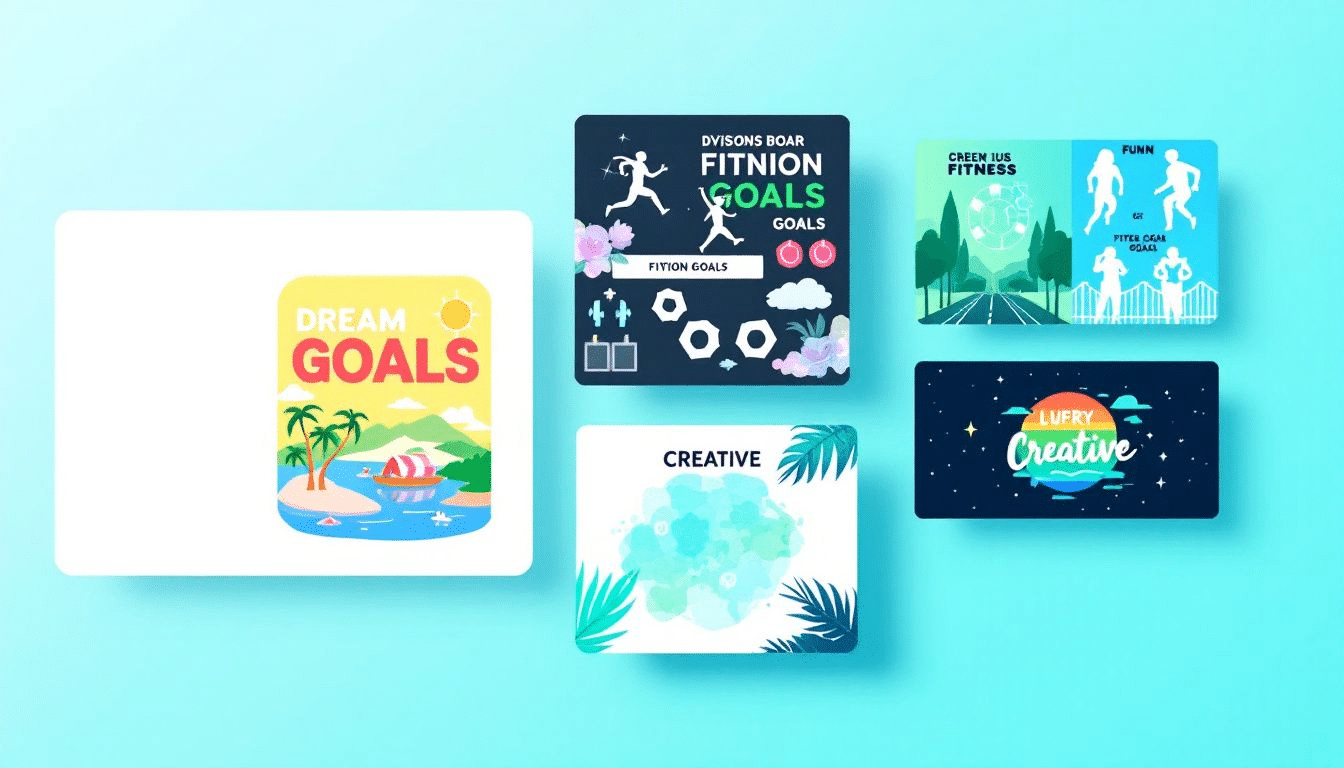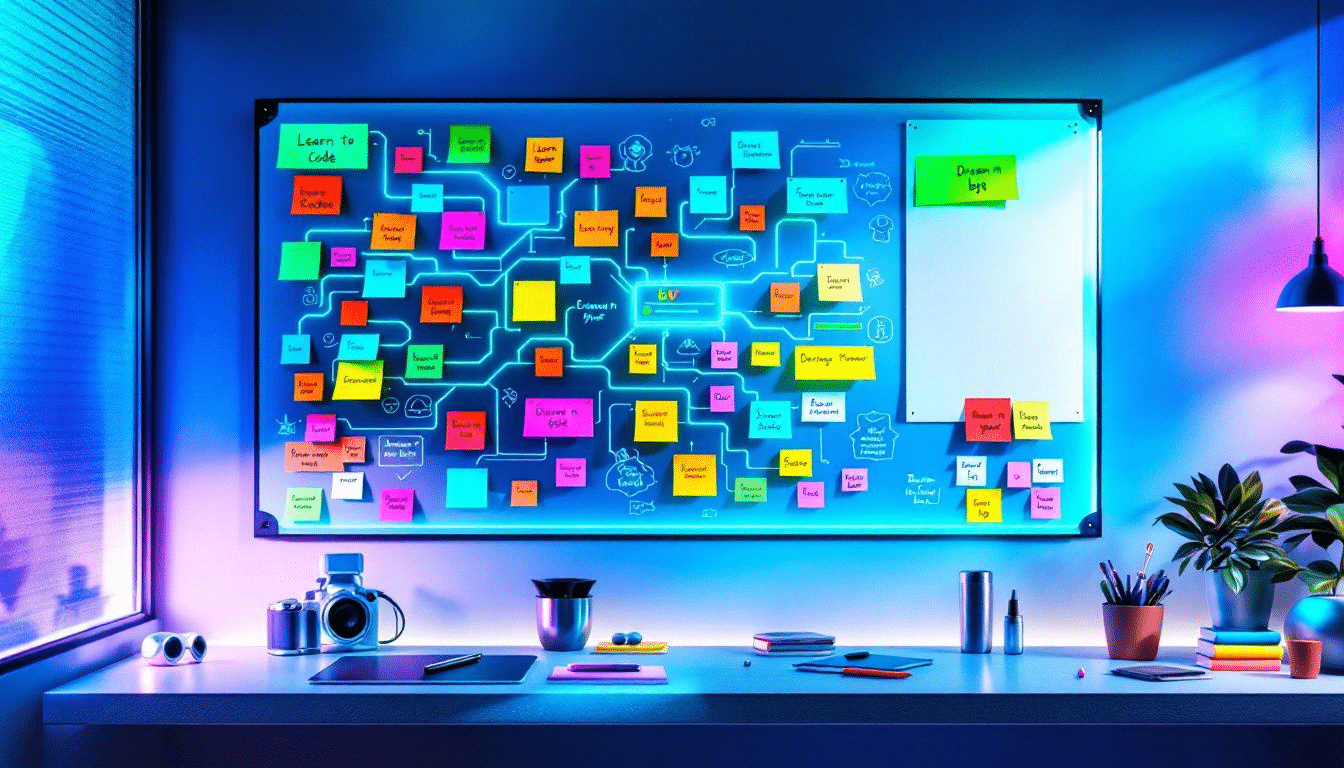Visual goal setting uses images to make goals clear and motivating. Learn how this method can keep you focused and turn your aspirations into reality.
Key Takeaways
Visual goal setting enhances motivation and engagement by making goals tangible through imagery, improving clarity and focus.
Utilizing tools like vision boards and mind maps helps break down ambitious goals into manageable tasks, fostering accountability and progress tracking.
Regularly updating and sharing visual goals with peers ensures relevance and accountability, keeping you committed to achieving your aspirations.
Mastering the Art of Visual Goal Setting

Visual goal setting is a technique that employs visual representations. It aims to enhance both personal and professional success. For individuals with ambitious goals, it is especially crucial to have a fast and simple way to break them down. This helps them stay focused and keep the end in mind. Visualization techniques involve creating detailed mental images of goals, which help in structuring actionable steps.
The beauty of visual goal setting lies in its simplicity and effectiveness. Translating your goals into visual formats makes them more tangible and easier to grasp. This method not only clarifies your objectives but also keeps you motivated and engaged, as the visual stimuli serve as constant reminders of what you’re working towards. Whether you’re aiming for a career milestone or a personal achievement, visual goal setting can provide the structure and focus needed to succeed.
In this blog post, we will explore various aspects of visual goal setting, including its benefits, methods, and practical tips for implementation. You’ll discover how to create vision boards, use mind maps, and leverage digital tools to track your progress and stay motivated. By mastering the art of visual goal setting, you’ll be well-equipped to turn your aspirations into achievements.
Introduction
Visual goal setting is a method that employs images and visual representations to express and pursue goals effectively. This approach can significantly enhance engagement and motivation, as it provides a clearer connection to personal aspirations. Using visual tools creates a vivid picture of your future, making it easier to stay focused and driven.
Throughout this blog post, we’ll explore various facets of visual goal setting, from its definition and core concepts to practical tips for implementation. You’ll gain insights into the benefits and methods of visual goal setting, setting the groundwork for achieving your aspirations.
Whether you’re an individual looking to reach personal milestones or a team aiming for collective success, visual goal setting can be a game-changer.
Understanding Visual Goals
Visual goal setting is a technique designed to enhance personal and professional success using visual representations. Individuals with ambitious goals need an efficient method to break them down. They must also stay focused and always keep the end result in mind.
Visualization techniques involve creating detailed mental images of goals, which help in structuring actionable steps. We’ll delve deeper into the definition and key concepts, and compare visual goal setting with traditional methods.
Definition and Key Concepts
Visual goal setting uses imagery to represent goals. It also involves various visual tools. This approach enhances commitment to goals by making aspirations tangible and visible. Key concepts include the use of imagery and visual representation tools like vision boards and mind maps. Vision boards are boards featuring images, quotes, and materials that represent goals. Mind mapping organizes goals visually, connecting main goals with sub-goals and action steps.
Visual tools activate the creative right side of the brain, promoting better engagement. Establishing a clear vision provides direction and purpose, breaking it into actionable specific goals. The integration of vision and goals created a roadmap, aligning efforts toward a common objective.
Visualizing your goals creates a more compelling and motivating representation of your aspirations.
Comparing Visual and Traditional Goal Setting
Visual goal setting is more memorable, emotionally resonant, and engages different parts of the brain compared to traditional methods. It leverages our natural ability to process and remember visual information, making it popular among productivity enthusiasts. Unlike traditional goal setting, which relies heavily on text, visual goal setting uses images and visual tools to create a clearer and more engaging roadmap for achieving goals.
This approach allows for easier tracking of progress and creates a clearer roadmap for achieving goals. Visual goal setting increases motivation and focus by making goals visually engaging. Incorporating visual elements helps individuals maintain a higher level of commitment and drive towards their objectives, making the goal-setting process more dynamic and effective.
Benefits of Visual Goal Setting

Implementing visual goal setting can lead to enhanced motivation and greater accountability. Teams that align their objectives with visual goals often experience increased collaboration and shared accountability among members.
Shared visual goals within a team can foster collaboration and significantly improve group dynamics. Let’s explore the specific benefits of visual goal setting in more detail.
Enhanced Clarity and Focus
Visual goal setting utilizes imagery to clarify and engage with personal and professional objectives. Creating a tangible representation of your goals provides a clearer understanding of what you aim to accomplish. Tools such as diagrams and vision boards present goals effectively, making them easier to grasp and stay focused on. This method promotes active engagement, which helps maintain focus despite distractions.
Creating a vision board can enhance clarity and focus on specific personal goals, like gaining skills in public speaking. Visual targets provide clarity and focus, allowing individuals to better understand their goals. Seeing your objectives and the steps required to achieve them helps maintain a strong sense of direction and purpose.
Boosted Motivation and Engagement
Visual goal setting fosters a deeper emotional connection to goals through its engaging nature. Utilizing visual techniques can significantly enhance motivation and focus among individuals, making them more driven to achieve their objectives. The use of images and colors can boost emotional engagement, making the goal-setting process more enjoyable and impactful.
Visual goal setting’s multifaceted approach engages various brain areas, contributing to improved motivation. Involving different cognitive processes compared to traditional methods, visual goal setting helps individuals stay motivated and committed to their goals. Success stories have shown that visual goal setting can help individuals maintain focus on their aspirations.
Effective Progress Tracking
Visual goal management solutions enhance clarity, allowing individuals to clearly track their progress. Visual formats provide a transparent overview of goals, helping individuals identify areas needing attention or improvement. Creating a straightforward way to monitor progress and adjust strategies ensures that goals are met.
A visual goal board creates a roadmap that simplifies recognizing progress and identifying needed adjustments. Visual goals enable you to recognize whether you’re on track or need to adjust your approach.
This transparency and clarity make it easier to stay focused and motivated, ultimately leading to more successful goal achievement.
Creating Your Visual Goals

Essential tools for visual goal setting include vision boards, mind maps, and dream charts. Methods used in visual goal setting comprise vision boards, mind maps, and digital tools.
The first step in creating a visual goal map is to gather colored markers and find a quiet place to work. Let’s explore these tools and methods in more detail.
Vision Boards
A vision board can include pictures and quotes that embody your aspirations and serve as motivation for daily action. Common materials and other materials to create a vision board include old magazines, scissors, glue, and a large piece of poster board or corkboard. Incorporating images and quotes that represent your goals, desires, and personal values creates a visually engaging and inspiring tool to keep you focused on your objectives.
Place your vision board in a location you frequently see, such as your bedroom wall or office space, to reinforce your goals daily. This constant visual reminder helps you stay motivated and committed to your dreams.
Vision boards are not just for individuals; teams can also create shared vision boards to align collective goals and enhance collaboration.
Mind Maps
Mind maps visually connect related ideas, making it easier to identify pathways toward achieving both main and sub-goals. This method allows you to break down larger objectives into smaller, manageable tasks, thus improving focus and clarity. Organizing your thoughts and goals in a visual format reveals the relationships between different elements and helps prioritize your actions effectively.
Using mind maps for visual goal setting can help you stay organized and maintain a clear understanding of your overall objectives. This tool is particularly useful for complex projects or goals that require detailed planning and execution. By visualizing the connections between different tasks, you can create a coherent strategy for achieving your goals.
Digital Tools and Apps
Some effective digital tools for visual goal setting include:
Trello, which uses boards and cards to help you visualize your tasks and progress
Notion, which offers a flexible workspace to create detailed plans and track milestones
Goalscape, which allows users to organize and track their goals in visually appealing ways
These platforms enable users to manage their goals effectively and keep track of their progress.
Customers describe Goalscape as intuitive and say it works the way their mind works. This tool’s user-friendly interface enhances the experience of visual goal setting, making it easier to stay motivated and focused on your objectives.
Leveraging digital tools allows the creation of a dynamic and interactive visual representation of your goals, accessible from anywhere.
Practical Tips for Successful Visual Goal Setting

Successful visual goal setting relies on clarity, focus, and actionable steps that guide individuals toward their objectives. Incorporating visual aids can enhance clarity and improve focus, making goal setting more effective. Regularly reviewing and adjusting goals ensures they remain relevant to changing priorities and circumstances.
Let’s delve into some practical tips for maintaining simplicity, staying focused, and sharing your goals.
Keep It Simple
Maintaining simplicity in visual goals prevents cognitive overload, helping individuals concentrate on the most significant aspects of their ambitions. Keeping visual representations straightforward and focused on primary objectives helps avoid distractions and maintain a clear understanding of what you aim to achieve.
Simplicity in visual goal representation helps prevent cognitive overload and ensures clearer focus. This approach allows you to concentrate on your core objectives and stay motivated without getting overwhelmed by unnecessary details. Focus on essential elements that resonate personally, rather than overwhelming visuals.
Regular Updates
Routine updates of visual goals ensure they remain relevant and reflective of evolving priorities and aspirations. Consistently revising and updating your visual goals aligns them with your current realities and personal development. This practice helps you stay motivated and committed to your objectives, even as circumstances change.
Updating visual goals regularly is essential to reflect evolving priorities for the year ahead, ensuring they remain relevant and motivating. This approach accommodates new aspirations and changing circumstances, keeping your goals dynamic and adaptable.
Regular check-ins can help maintain focus on visual goals amidst distractions.
Share and Reflect
Sharing visual goals with others fosters accountability and provides opportunities for constructive feedback, which can sustain motivation and progress. Discussing your visual goals with supportive peers can enhance accountability and facilitate constructive reflection on progress. This collaborative approach can help you stay on track and make necessary adjustments to your strategies.
Discussing visual goals with trusted peers can enhance accountability and motivate ongoing progress. Sharing your goals can provide valuable insights and support from others, making the goal-setting process more engaging and effective. This practice helps reinforce your commitment to achieving your objectives.
Overcoming Common Challenges
Visual goal setting can become overwhelming due to the complexity of goals and the amount of information presented. Effective goal visualization enhances decision-making, allowing individuals to break down objectives into manageable tasks while adapting to new challenges.
Let’s explore how to avoid visual overload, stay flexible, and maintain consistency.
Avoiding Visual Overload
To maintain clarity, focus on essential elements that resonate personally, rather than overwhelming visuals. Using simple visuals can effectively convey messages without overwhelming viewers. Incorporating fewer colors and simpler shapes helps maintain focus and reduce distractions in visual goal setting.
Incorporating regular breaks from visual stimuli can enhance concentration and prevent fatigue. This approach helps you stay focused on your goals without getting overwhelmed by excessive visual information. Keeping visual elements straightforward and meaningful can make your goal-setting process more effective.
Staying Flexible
Flexibility is important in visual goal setting to adapt to new circumstances and reflect changing aspirations. Adapting your visual goals maintains their relevance as personal circumstances change. This approach ensures that your goals remain aligned with your evolving priorities and aspirations.
Adapting goals to changing circumstances can lead to more effective outcomes and sustained momentum towards achieving the vision. Flexibility allows you to make necessary adjustments and stay motivated, even when faced with unexpected challenges. This adaptability is crucial for maintaining long-term commitment to your goals.
Maintaining Consistency
Consistency is crucial in visual goal setting, as it helps ensure that individuals remain aligned with their long-term objectives. Regularly revisiting visual goals and updating them helps reinforce focus and accountability. Maintaining a consistent routine helps stay committed to your goals and make steady progress towards achieving them.
When faced with distractions or setbacks, it is essential to reflect on the reasons behind the distraction and reestablish commitment to the visual goals. This practice helps you stay focused and motivated, even when challenges arise.
Consistency in visual goal setting is key to long-term success and achieving your aspirations.
Case Studies and Success Stories

Real-life testimonials illustrate how visual goal setting can serve as a powerful motivator and clarity tool for individuals and teams. These examples underscore the practical benefits of visual goal setting, proving its effectiveness in driving both individual aspirations and team objectives.
Let’s explore some personal success stories and team achievements.
Personal Success Stories
Sarah, a marketing professional, achieved a promotion after creating a vision board that motivated her to take actionable steps towards her career goals. Mark improved his health and fitness significantly by using a vision board to remind him of his wellness goals and the lifestyle changes he wanted to make. Emily enhanced her personal development by using a vision board to visualize her goals, which led her to read more and attend workshops.
A personal vision board can lead to unexpected opportunities in public speaking and engagement with various audiences. Individuals often achieve significant personal milestones through the practice of visual goal setting, leveraging tools like vision boards.
These stories highlight the transformative power of visual goal setting in personal growth and success.
Team Achievements
Unified company goals provide a clear direction for teams, enhancing collaboration and efficiency. Having shared objectives encourages open communication among team members, leading to improved team dynamics. Support for unified goals significantly boosts team engagement and motivation, making staff feel valued and aligned with the company vision.
Visual goals serve as a powerful tool for teams to visualize their shared objectives and track progress, ultimately driving collective success. For example, a team of marketing professionals implemented effective visual goal tracking using a shared digital vision board, resulting in a 30% increase in campaign efficiency over a quarter.
These examples demonstrate how visual goal setting can enhance team performance and achieve remarkable results.
Summary
Visual goal setting is a transformative approach that leverages the power of imagery and visual representations to make goals more engaging and achievable. By using tools like vision boards, mind maps, and digital apps, individuals and teams can enhance clarity, boost motivation, and track progress effectively. The benefits of visual goal setting are evident in the enhanced focus, emotional engagement, and improved collaboration it fosters.
As you embark on your visual goal-setting journey, remember to keep your goals simple, regularly update them, and share them with others for accountability and support. Overcoming challenges like visual overload and staying flexible are crucial for maintaining long-term commitment. By implementing these strategies, you can turn your aspirations into reality and achieve your dreams. So, go ahead and create your visual goals—your future self will thank you.
Frequently Asked Questions
What is visual goal setting?
Visual goal setting is a powerful technique that helps you express and pursue your goals through images and diagrams, making your aspirations more tangible and motivating. Embrace it to transform your dreams into clear, actionable steps!
How can vision boards help in achieving goals?
Vision boards are powerful tools that keep your aspirations in sight, providing daily motivation and clarity. By visually reinforcing your goals, they can significantly boost your chances of achieving them!
What are some effective digital tools for visual goal setting?
For powerful visual goal setting, try using Trello, Notion, or Goalscape; these tools make it easy to organize and track your aspirations. Embrace their visual appeal and watch your goals come to life!
How can visual goal setting enhance team performance?
Visual goal setting can significantly boost team performance by clarifying objectives and strengthening collaboration and communication among members. Embrace this approach to empower your team and achieve greater success together!
What are some common challenges in visual goal setting?
Visual goal setting can be tricky due to potential overload from too many visuals, the need to remain flexible, and the importance of consistency. Stay focused on clear, motivating visuals that inspire you!




